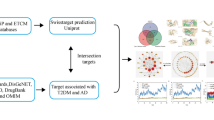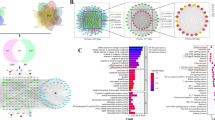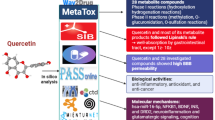Abstract
Parkinson’s disease (PD) is a chronic, progressive, and second most prevalent neurological disorder affecting the motor system. It has been found that people suffering with inflammatory bowel disease (IBD) are at 22% more risk for PD. In the current study, we have established a molecular link between gut and brain. The microarray gene expression datasets of Homo sapiens were obtained from Gene Expression Omnibus Database. Major genes involved in gut-brain connection were found to be CXCR4, LRRK2, APOE, SNCA, IL6, HIF-1α, ABCA1 etc. The common biological pathways linking both the pathologies were found to be HIF-signaling, cytokines interactions, JAK-STAT pathway, cholesterol metabolism, apoptosis and CXCR4 signaling which modulates the synaptic function and neuronal survival in the mature brain. It is known that flavonoid-rich foods throughout life hold the potential to limit the inflammation, neurodegeneration and, to prevent the age-dependent cognitive impairment. Therefore, the potential receptor, CXCR4 was used further for docking with twenty-seven phytochemicals from 5 different classes of Flavonoids found in several dietary items. Docking studies of the top scoring compounds were compared with a known inhibitor (BPRCX807) of receptor CXCR4 (IC50 = 40.4 ± 8.0 nM). The study indicates that Flavan-3-ol families of flavonoids are the best fit and finest dietary supplements for improving brain health. Hence the food items like Pistachio nuts, hazelnuts, Green Tea, walnuts, etc. should be incorporated more in the diet of healthy people as well as in IBD and PD patients to prevent inflammation in gut and brain damage from oxidative stress.
Graphical Abstract









Similar content being viewed by others
Data availability
All data generated or analyzed during this study are included in this article.
References
Bagheri V, Khorramdelazad H, Hassanshahi G, Moghadam-Ahmadi A, Vakilian A (2018) CXCL12 and CXCR4 in the peripheral blood of patients with Parkinson’s disease. NeuroImmunoModulation 25(4):201–205
Barazzuol L, Giamogante F, Brini M, Calì T (2020) PINK1/Parkin Mediated Mitophagy, Ca2+ Signalling, and ER–Mitochondria Contacts in Parkinson’s Disease. Int J Mol Sci 21(5):1772
Bernardazzi C, Pêgo B, de Souza HS (2016) Neuro immune modulation in the gut: focus on inflammatory bowel disease. Mediators of inflammation.
Bowers KJ, Chow E, Xu H, et al (2006) Scalable algorithms for molecular dynamics simulations on commodity clusters. In: Proceedings of the 2006 ACM/IEEE conference on Supercomputing. Association for Computing Machinery, Tampa, Florida, pp 84-es
Bowser JL, Phan LH, Eltzschig HK (2018) The hypoxia–adenosine link during intestinal inflammation. J Immunol 200(3):897–907
Brudek T (2019) Inflammatory Bowel Diseases and Parkinson’s Disease. Journal of Parkinson's disease 1–4
Cabezudo D, Baekelandt V, Lobbestael E (2020) Multiple-hit hypothesis in Parkinson’s disease: LRRK2 and inflammation. Frontiers in Neuroscience 14.
Cersosimo MG, Raina GB, Pecci C, Pellene A, Calandra CR, Gutiérrez C, Micheli FE, Benarroch EE (2013) Gastrointestinal manifestations in Parkinson’s disease: prevalence and occurrence before motor symptoms. J Neurol 260(5):1332–1338
Dogra N, Mani RJ, Katare DP (2021) The gut-brain axis: Two ways signaling in Parkinson’s disease. Cell Mol Neurobiol 2:1–8
Essmann U, Perera L, Berkowitz ML, Darden T, Lee H, Pedersen LG (1995) A smooth particle mesh Ewald method. J Chem Phys 103(19):8577–93
Ferré S, Bonaventura J, Zhu W, Hatcher-Solis C, Taura J, Quiroz C, Cai NS, Moreno E, Casadó-Anguera V, Kravitz AV, Thompson KR (2018) Essential control of the function of the striatopallidal neuron by pre-coupled complexes of adenosine A2A-dopamine D2 receptor heterotetramers and adenylyl cyclase. Front Pharmacol 9:243
Field FJ, Watt K, Mathur SN (2010) TNF-α decreases ABCA1 expression and attenuates HDL cholesterol efflux in the human intestinal cell line Caco-2. J Lipid Res 51(6):1407–1415
Friesner RA, Banks JL, Murphy RB, Halgren TA, Klicic JJ, Mainz DT, Repasky MP, Knoll EH, Shelley M, Perry JK, Shaw DE (2004) Glide: a new approach for rapid, accurate docking and scoring. 1. Method and assessment of docking accuracy. J Med Chem 47(7):1739–49
Hajjar AM, Ernst RK, Tsai JH, Wilson CB, Miller SI (2002) Human Toll-like receptor 4 recognizes host-specific LPS modifications. Nat Immunol 3(4):354–359
Hu S, Yuan J, Xu J, Li X, Zhang G, Ma Q, Zhang B, Hu T, Song G (2019) TNF-α and IFN-γ synergistically inhibit the repairing ability of mesenchymal stem cells on mice colitis and colon cancer. Am J Transl Res 11(9):6207
Jorgensen WL, Maxwell DS, Tirado-Rives J (1996) Development and Testing of the OPLS All-Atom Force Field on Conformational Energetics and Properties of Organic Liquids. J Am Chem Soc 118:11225–11236. https://doi.org/10.1021/ja9621760
Jung YJ, Isaacs JS, Lee S, Trepel J, Neckers L (2003) IL-1β-mediated up-regulation of HIF-1α via an NFκB/COX-2 pathway identifies HIF-1 as a critical link between inflammation and oncogenesis. FASEB J 17(14):2115–2117
Kaiyrzhanov R, Rizig M, Aitkulova A, Zharkinbekova N, Shashkin C, Kaishibayeva G, Karimova A, Khaibullin T, Sadykova D, Ganieva M, Rasulova K (2019) Parkinson’s Disease in Central Asian and Transcaucasian Countries: A Review of Epidemiology, Genetics, Clinical Characteristics, and Access to Care. Parkinson’s Disease.
Kalkonde YV, Morgan WW, Sigala J, Maffi SK, Condello C, Kuziel W, Ahuja SS, Ahuja SK (2007) Chemokines in the MPTP model of Parkinson’s disease: absence of CCL2 and its receptor CCR2 does not protect against striatal neurodegeneration. Brain Res 1128:1–1
Kaminski GA, Friesner RA, Tirado-Rives J, Jorgensen WL (2001) Evaluation and Reparametrization of the OPLS-AA Force Field for Proteins via Comparison with Accurate Quantum Chemical Calculations on Peptides. J Phys Chem B 105:6474–6487. https://doi.org/10.1021/jp003919d
Kho ZY, Lal SK (2018) The human gut microbiome–a potential controller of wellness and disease. Front Microbiol 9:1835
Kim S, Eun HS, Jo EK (2019) Roles of autophagy-related genes in the pathogenesis of inflammatory bowel disease. Cells 8(1):77
Klingelhoefer L, Reichmann H (2015) Pathogenesis of Parkinson disease—the gut–brain axis and environmental factors. Nat Rev Neurol 11(11):625
Kohl M, Wiese S, Warscheid B (2011) Cytoscape: software for visualization and analysis of biological networks. InData Mining in Proteomics (pp. 291–303). Humana Press
Kwon JH, Lee J, Kim J, Jo YH, Kirchner VA, Kim N, Kwak BJ, Hwang S, Song GW, Lee SG, Yoon YI (2019) HIF-1α regulates A2B adenosine receptor expression in liver cancer cells. Exp Ther Med 18(6):4231–4240
Liu Z, Yan S, Wang J, Xu Y, Wang Y, Zhang S, Xu X, Yang Q, Zeng X, Zhou Y, Gu X (2017) Endothelial adenosine A2a receptor-mediated glycolysis is essential for pathological retinal angiogenesis. Nat Commun 8(1):1–8
Ma X, Dai Z, Sun K, Zhang Y, Chen J, Yang Y, Tso P, Wu G, Wu Z (2017) Intestinal epithelial cell endoplasmic reticulum stress and inflammatory bowel disease pathogenesis: an update review. Front Immunol 8:1271
Marras C, Beck JC, Bower JH, Roberts E, Ritz B, Ross GW, Abbott RD, Savica R, Van Den Eeden SK, Willis AW, Tanner CM (2018) Prevalence of Parkinson’s disease across North America. NPJ Parkinson’s Disease 4(1):21
Masoud ST, Vecchio LM, Bergeron Y, Hossain MM, Nguyen LT, Bermejo MK, Kile B, Sotnikova TD, Siesser WB, Gainetdinov RR, Wightman RM (2015) Increased expression of the dopamine transporter leads to loss of dopamine neurons, oxidative stress and l-DOPA reversible motor deficits. Neurobiol Dis 74:66–75
McEntee CP, Gunaltay S, Travis MA (2020) Regulation of barrier immunity and homeostasis by integrin-mediated transforming growth factor β activation. Immunology 160(2):139–148
Meiser J, Weindl D, Hiller K (2013) Complexity of dopamine metabolism. Cell Commun Signal 11(1):34
Nair AT, Ramachandran V, Joghee NM, Antony S, Ramalingam G (2018) Gut Microbiota Dysfunction as Reliable Non-invasive Early Diagnostic Biomarkers in the Pathophysiology of Parkinson’s Disease: A Critical Review. J Neurogastroenterol Motil 24(1):30
O’Hara DM, Pawar G, Kalia SK, Kalia LV (2020) LRRK2 and α-Synuclein: Distinct or Synergistic Players in Parkinson’s Disease?. Front Neurosci 14
Petrey AC, Carol A (2017) The extracellular matrix in IBD: a dynamic mediator of inflammation. Curr Opin Gastroenterol 33(4):234
Pickrell AM, Youle RJ (2015) The roles of PINK1, parkin, and mitochondrial fidelity in Parkinson’s disease. Neuron 85(2):257–273
Randall-Demllo S, Chieppa M, ERI RD, (2013) Intestinal epithelium and autophagy: partners in gut homeostasis. Front Immunol 4:301
Rastegar DA, Dzamko N (2020) Leucine Rich Repeat Kinase 2 and Innate Immunity. Frontiers in Neuroscience 14.
Shimoji M, Pagan F, Healton EB, Mocchetti I (2009) CXCR4 and CXCL12 expression is increased in the nigro-striatal system of Parkinson’s disease. Neurotox Res 16(3):318–328
Ricciotti E, FitzGerald GA (2011) Prostaglandins and inflammation. Arterioscler Thromb Vasc Biol 31(5):986–1000
Scardoni G, Tosadori G, Laudanna C, Fabbri F, Faizaaan M (2009) CentiScaPe: Network centralities for Cytoscape
Soufli I, Toumi R, Rafa H, Touil-Boukoffa C (2016) Cytokines and nitric oxide in immunopathogenesis of ibd and potential therapeutic approaches. New Insights into Inflammatory Bowel Disease 26:125
Stojkovska I, Krainc D, Mazzulli JR (2018) Molecular mechanisms of α-synuclein and GBA1 in Parkinson’s disease. Cell Tissue Res 373(1):51–60
Tolstanova G, Deng X, Ahluwalia A, Paunovic B, Prysiazhniuk A, Ostapchenko L, Tarnawski A, Sandor Z, Szabo S (2015) Role of dopamine and D2 dopamine receptor in the pathogenesis of inflammatory bowel disease. Dig Dis Sci 60(10):2963–2975
Travis MA, Sheppard D (2014) TGF-β activation and function in immunity. Annu Rev Immunol 32:51–82
Uemura N, Yagi H, Uemura MT, Hatanaka Y, Yamakado H, Takahashi R (2018) Inoculation of α-synuclein preformed fibrils into the mouse gastrointestinal tract induces Lewy body- like aggregates in the brainstem via the vagus nerve. Mol Neurodegener 13(1):21
Verma N, Ahuja V, Paul J (2013) Profiling of ABC transporters during active ulcerative colitis and in vitro effect of inflammatory modulators. Dig Dis Sci 58(8):2282–2292
Wang H, Eckel RH (2014) What are lipoproteins doing in the brain? Trends Endocrinol Metab 25(1):8–14
Werner L, Guzner-Gur H, Dotan I (2013) Involvement of CXCR4/CXCR7/CXCL12 Interactions in Inflammatory bowel disease. Theranostics 3(1):40
Woodward OM, Köttgen A, Köttgen M (2011) ABCG transporters and disease. FEBS J 278(18):3215–3225
Xu M, Zhang S, Zhao H, Ma C, Pan Y (2019) Association between nucleotide-binding oligomerization domain protein 2 (NOD2) gene polymorphisms and Parkinson’s disease (PD) susceptibility. Artif Cells Nanomed Biotechnol 47(1):2134–2138
Acknowledgements
We acknowledge Dr. Ashok Chauhan, Founder, Amity University, for providing us infrastructure and facilities. We also acknowledge the NPDF fellowship and support given to Dr. Angamba Meetei Potshangbam by DST SERB.
Funding
University Grant Commission (Government of India) had granted senior research fellowship to Nitu Dogra for undertaking this project (Award No:324872).
Author information
Authors and Affiliations
Contributions
ND, RJM and AMP have performed the experiments and wrote the manuscript. ND and RJM performed bioinformatics and network biology and AMP performed docking and simulation work. ND, RJM, AMP, SB and DPK have edited and finalized the manuscript.
N.D, R.J.M, A.M.P, S.B did the analysis and wrote the manuscript. D.P.K conceptualized the study and finalized the manuscript.
Corresponding author
Ethics declarations
Ethics
No ethical approval is required.
Conflict of interest
Authors have no conflict of interest to report.
Additional information
Publisher's Note
Springer Nature remains neutral with regard to jurisdictional claims in published maps and institutional affiliations.
Supplementary Information
Below is the link to the electronic supplementary material.
Rights and permissions
Springer Nature or its licensor (e.g. a society or other partner) holds exclusive rights to this article under a publishing agreement with the author(s) or other rightsholder(s); author self-archiving of the accepted manuscript version of this article is solely governed by the terms of such publishing agreement and applicable law.
About this article
Cite this article
Dogra, N., Jakhmola-Mani, R., Potshangbam, A.M. et al. CXCR4 as possible druggable target linking inflammatory bowel disease and Parkinson's disease. Metab Brain Dis 38, 1079–1096 (2023). https://doi.org/10.1007/s11011-022-01155-6
Received:
Accepted:
Published:
Issue Date:
DOI: https://doi.org/10.1007/s11011-022-01155-6




